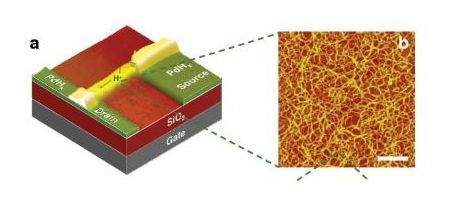Materials scientists at the University of Washington have built a transistor that uses protons rather than electrons, in a breakthrough that could allow devices to communicate directly with living things.

While electronic devices send information using electrons, the human body sends signals and performs work using ions or protons.
“So there’s always this issue, a challenge, at the interface – how does an electronic signal translate into an ionic signal, or vice versa?” says Marco Rolandi, assistant professor of materials science and engineering.
“We found a biomaterial that is very good at conducting protons, and allows the potential to interface with living systems.”
In the body, protons activate ‘on’ and ‘off’ switches, and are key players in biological energy transfer. Ions open and close channels in the cell membrane to pump things in and out of the cell, and are also used to flex muscles and transmit brain signals.
A machine that was compatible with a living system in this way could monitor such processes – and, one day, could generate proton currents to control certain functions directly.
The UM transistor is a first step towards this, as it can send pulses of proton current. It’s a field-effect transistor, a basic type that includes a gate, a drain and a source terminal for the current. It measures about five microns wide.
“In our device, large bioinspired molecules can move protons, and a proton current can be switched on and off, in a way that’s completely analogous to an electronic current in any other field effect transistor,” says Rolandi.
The device uses a modified form of the compound chitosan. It’s compatible with living things, is easily manufactured, and can be recycled from crab shells and squid pen discarded by the food industry.
Chitosan works remarkably well at moving protons, says the team, absorbing water and forming many hydrogen bonds; protons are then able to hop from one hydrogen bond to the next.
“So we now have a protonic parallel to electronic circuitry that we actually start to understand rather well,” says Rolandi.
The next step, says Rolandi, will be direct sensing of cells in a laboratory. The current prototype has a silicon base and couldn’t be used in a human body.
Longer term, however, a biocompatible version could be implanted directly in living things to monitor, or even control, certain biological processes directly.






